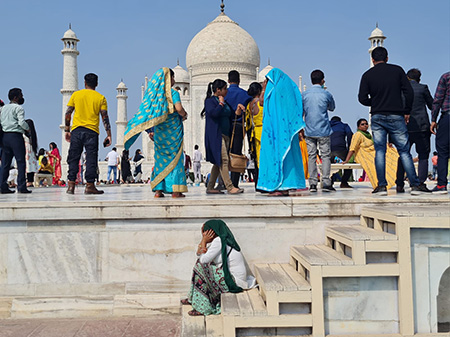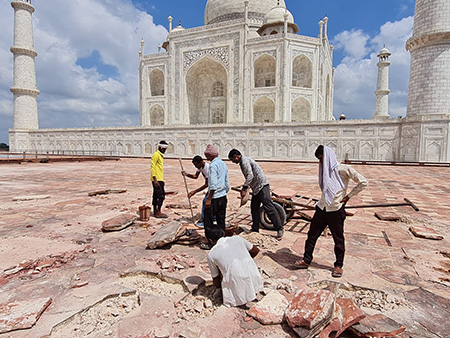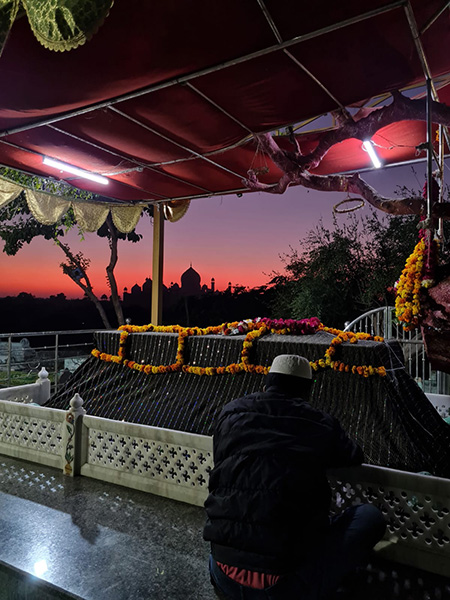Fieldwork
The monument multiple: everyday life in the vicinity of the Taj Mahal
I conducted fieldwork with people who work and live in Taj Ganj, a neighbourhood in the immediate vicinity of the Taj Mahal in Agra, India. A site of mass tourism and glorious national heritage, this 17th century mausoleum of Mughal royalty is now a fiercely contested symbol of Indian nationhood. What does this place of extraordinary beauty mean to those people who live in its immediate vicinity? How is the Taj Mahal their heritage? Taj Ganj’s residents increasingly contend with a confrontational state that views them as threats to the Taj Mahal’s preservation. Set apart from the neighbourhood the Taj Mahal transforms from a site abundant with social life into a congregation of lifeless stone. My interlocutors find it untenable that the Taj Mahal be untethered from their daily lives; to them it is always more than a mere monument, it is a site of multiple meanings as a place of private and government employment, the shrine of a benevolent king revered as a Sufi saint, a contested site as a lost temple, and a source of aesthetic pleasure. My dissertation explores this local idea of the Taj Mahal’s heritage as the ‘monument multiple’. The pictures I’ve chosen reflect some aspects of how my interlocutors understand the Taj Mahal as a site of intersecting multiplicity: indeed, each make sense only in the context of the other. Anthropological attention to monuments reveals the complex ways people imagine, comprehend, and contest the meaning of the past in their everyday lives;, compelling us to ask: how does the extraordinary become ordinary?
The allure of magnetism: tourists at the Taj Mahal
I often heard the residents of Taj Ganj, especially those people who work as tour guides and photographers, describe the Taj Mahal as a powerful magnet (chumbak). The iconic mausoleum compels people from across the world to visit Taj Ganj giving its residents the joys of livelihood. The monument is evocatively praised as Agra’s “engine” or as Taj Ganj’s “father”: leading my interlocutors towards the promises of success and progress. The world comes to Taj Ganj but its gaze is captivated by the magnetic aura of the marble mausoleum.
Making monument makers: the labour of producing the Taj Mahal
Mass tourism is perilous to the body of the monument. The millions of tourists visiting the Taj Mahal exacerbate its decay that is adversely affected by environmental pollution and neglect. Though Taj Ganj residents say that the decay is as inevitable as new clothes losing colour after repeated washing, they recognise the immense labour involved in the preserving the Taj Mahal’s architecture. The monument is the site of hard and unrewarding work of hundreds of masons, caretakers, and bureaucrats whose everyday activities produce the Taj Mahal. It is indeed ironical that the masons’ expertise in their work makes their contributions to the monument’s long life invisible. There are other ways these Taj Ganj residents find meaning in their work of producing the monument. As a site of ancestral work, engaging with stone in the “old way”, my interlocutors speak of themselves as doing the important work of sustaining its life through their embodied craft practice. To masons, the monument is more than an assemblage of old stones to be abandoned, it is instead a living presence, an elderly relative in need of love and care.
Auspicious sight, or seeing as ingestion: the Taj Mahal as dargah
The state invests immense resources to preserve the Taj Mahal’s exceptional beauty for tourists. My interlocutors, however, comprehend the monument’s sublime architecture devotionally as well. Muslims and Hindus revere the entombed royals as Sufi saints: benevolent figures with the miraculous power to cure, heal, and intercede on behalf of those who seek their aid. Contending with a state that sees religious practice as a threat to conservation, my interlocutors engage in different forms of communion with the saints: they do through sight what they would otherwise have done through touch. My interlocutors recognise that the saints’ miraculous power manifests as their shrine – the Taj Mahal’s – architectural beauty. By making the shrine the focus of intense, exalted viewing, Muslims and Hindus in Taj Ganj ingest the power emanating from the saints enshrined within. My interlocutors would often visit other shrines in the neighbourhood such as the Dargah Ahmed Bukhari in this photograph that offered remarkable views of the Taj Mahal. Distant from the cantankerous bazaar, the sylvan and devotional environment of the shrine – known in neighbourhood genealogies as a guardian of the Taj Mahal – offers my interlocutors the opportunity to engage in an aesthetically-mediated form of prayer. Gazing at the Taj Mahal devotionally is a form of being in communion with saints. This auspicious sight heals, replenishes, it gives to those who seek it, sukun - peace and tranquillity.
These three photographs offer a glimpse into how Taj Ganj residents engage in the multiplicity of the Taj Mahal in their daily lives. It is in these ordinary ways that the monument – celebrated as a global, non-place – comes to be known in all its contradictions, ambiguities, and pleasures.



